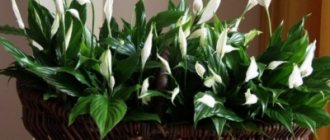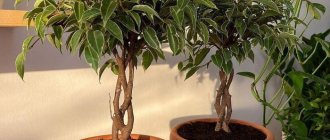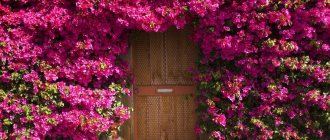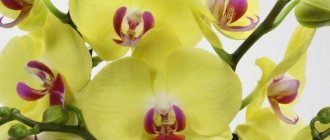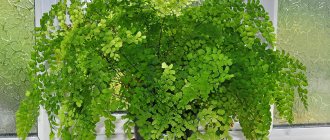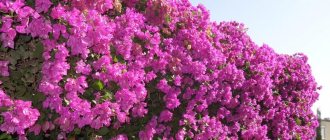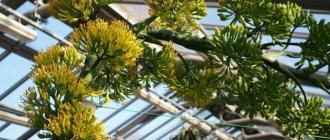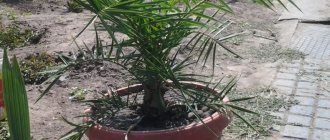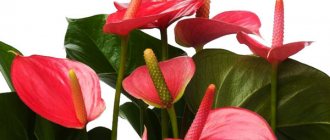Anthurium is a tropical plant, which popularly has another name, the flower “male happiness”. It attracts lovers of indoor floriculture with its unpretentiousness and bright, original appearance. If you provide the anthurium with good conditions and care, it will bloom at home all year round. You can purchase a flower in any decorative gardening department.
Popular varieties of anthurium
The list of the most popular and popular varieties includes the following:
- Black Love;
- Dynamite Red;
- Majestic;
- Rothschild.
These varieties are the most unpretentious and easy to care for. But there are other varieties that are less known to domestic lovers of indoor floriculture; They are also distinguished by their beauty and ease of maintenance.
Andre (Andreanum)
Andrianum is a popular and unpretentious variety. This plant will adequately decorate any interior. Distinctive features are thick leaves, small inflorescences and a bright scarlet cover. Sometimes the "sail" may be purple or white. The plant does not like high humidity, unlike other varieties.
Black Queen
This variety is often called "Black Queen" or "Black Prince". This species is one of the largest, more than a meter in height. The leaves are large, oblong. The flowers are dark purple, almost black. This species has good immunity.
Black Love
Tall plant with many branches, height 50 cm. Dark green heart-shaped leaves. The buds are beige at first, and then become purple, almost black. The plant loves a lot of light and does not tolerate shade.
Scherzer (Anthurium scherzerianum)
Scherzerianum is a rather rare variety of anthurium. The cob is twisted in the shape of a spiral, the cover is a rich bright orange color. The berries appear at the same time as the flowers. The plant loves warmth and humidity.
Dynamite Red
The bract is bright scarlet with a curved shape, and the flower itself is yellow. The flower is not tall, about 40 cm. The leaves are light green, heart-shaped, medium in size. This type of anthurium does not tolerate cold.
Utah
This is a hybrid variety with wide dark green leaves, which are decorated on the inside with an intricate pattern - longitudinal stripes. The blanket gradually changes its color; at the beginning of flowering it is pinkish, then gradually becomes purple. This species is often attacked by insect pests.
Princess Amalia Elegance
It is one of the four most popular varieties in Russia. The leaves are wide, heart-shaped, the large cob is dark pink. The round bract can be white or dark cherry. The variety does not like excessive soil moisture.
Adios
This variety has two more unofficial names - “Salmon” and “Spring Romance”. The height of an adult plant is 65 cm, the ear is bright yellow, small inflorescences are white. The inflorescence has the shape of a tulip. The flower loves heat and abundant watering.
Prince Orange
This is a medium-height hybrid anthurium variety whose dark green heart-shaped leaves, yellow bracts and orange spathe look beautiful and harmonious together. When caring, you should pay special attention to the temperature regime; the plant is afraid of cold weather.
Pink Champion
The variety was artificially bred in Holland. The pink blanket reaches 17–20 cm in length. Large pink flowers stay on the bush for a long time, after which red berries appear. The plant is often affected by rot, in which case watering should be reduced.
Majestic (Magnificum)
One of the most beautiful varieties, the heart-shaped dark green leaves are decorated with intricate, sinuous veins. The yellow bract stands out effectively against the background of the scarlet blanket. The plant is unpretentious and responds well to feeding.
Rothschildianum
The variety was developed by crossing the white and red Scherzer varieties. The height of the bush is 45 cm, the bright pink cover effectively sets off the dark green leaves without patterns. Visually, the flowers look a little like roses. This variety is one of the most moisture-loving.
Joli Peach
A hybrid variety up to 60 cm high, its distinctive feature is abundant flowering. The soft pink spathe and beige bract with small yellow flowers make this plant a favorite of domestic gardeners. However, to extend the flowering period, the plant needs feeding.
Cavalli
One of the most unpretentious varieties. However, if the room is cold, this plant will not bloom. The leaves are light green, rounded, with dark veins. The spathe and bract are purple, sometimes bright pink.
Baby Purple
This is a low-growing variety, the height of the bush is no more than 30 cm. However, the flowers are quite large, up to 6 cm in diameter. The leaves are dark green, the bract and spathe are purple. The leaves have an unusual triangular shape. The plant needs regular loosening and frequent watering.
Dakota
The height of an adult bush is up to 40 cm, the leaves are oblong, slightly elongated, elliptical in shape. The color of the leaves is light green, the cover is bright scarlet, the bract is pink. Distinctive features are abundant and long flowering. The plant needs regular mineral feeding.
Crystal (Crystallinum)
This variety blooms very rarely at home and is sensitive to temperature changes. Indoor gardeners plant it because of its beautiful patterned leaves. The plant can climb like a vine and requires support in the form of a stick or slate to grow.
Sierra Maqic
This variety is distinguished by fleshy large light green leaves without veins or patterns. The spathe is bright pink, the bract and flowers are dark red, this spectacular contrast immediately catches the eye. Flowering is short-lived; to prolong it, it is necessary to increase watering and feed the flower with mineral fertilizers.
Sweet Dream
The plant is not tall, the bush is up to 40 cm in height. Distinctive features are abundant and lush, but short-lived flowering. The leaves are graceful, oblong in shape, with light veins. The spathe is pink, the bract is yellow. The flowers are small and do not fall off for a long time; they appear after the berries. The flower is sensitive to cold and lack of light.
Karma Purple
It is a low-growing plant, the height of an adult bush does not exceed 20 cm, but the flowers are quite large and can reach 8 cm in diameter. The plume is fuchsia, the bract is lilac, the leaves are light green without patterns, heart-shaped. The flower does not tolerate shade and loves the sun.
Lilli
This species got its name due to the fact that the color is similar in appearance to a lily. This is a dwarf variety, the height of an adult bush is no more than 20 cm. The train is narrow, ribbon-like, pale pink in color. The leaves are oblong, monochromatic, without veins. The plant is unpretentious.
Princess Alexia Jade
This variety rarely blooms, but lush greenery performs a decorative function. Heart-shaped dark green leaves are decorated with an intricate pattern of light specks. The plume is light green, the bract is yellow. The flower is unpretentious, but is afraid of drafts.
Rainbow Champion
Medium-sized bush, up to 40 cm in height. The leaves are two-colored: dark green on the outside, light green on the inside. Flowers can be orange, brown or pink, with a purple or fuchsia plume. This variety loves abundant feeding.
Black Beauty
Tall variety, bush height up to 55 cm. The cover is dark brown, almost black. The leaves are fleshy, juicy, heart-shaped, with raised veins. Heat-loving and moisture-loving variety.
Clarinervium
The flowers are not very large, the plant blooms rarely, the cover is beige. The decorative function is performed by foliage; dark green heart-shaped leaves are decorated with a light green pattern. The plant loves high humidity, but does not tolerate direct sunlight.
Livium
A high variety, the average height of an adult specimen is up to 60 cm. The leaves are leathery, dense, dark green, with prominent veins. The plume is light pink, with pink stripes, the bract is orange. The plant tolerates heat well, but does not tolerate cold well.
Vanilla
The leaves are dark green without patterns, the trail is two-colored - beige and yellow. The bract is orange, small flowers are brown. The height of the plant is no more than 40 cm. The main requirements are abundant watering and loosening.
Sierra White
The bush reaches 50 cm in height, the heart-shaped leaves are dark, without patterns or veins, dense and leathery. The cover is snow-white, the bracts and small flowers are yellow, the berries are orange. The variety is unpretentious and tolerates drafts well.
Zizou
It blooms rarely, the height of an adult bush is up to 40 cm. The leaves are oblong with pointed ends, decorated with openwork veins and perform the main decorative function. Abundant flowering is possible only with regular watering.
Fantasy Love
The bush is medium in size, up to 40 cm, the cover is white with splashes of pink, dark veins stand out effectively on the light leaves. The buds and berries are larger than other varieties. The basic care requirements are no shade and plenty of sunlight.
Violet Heart
Fleshy triangular leaves without patterns are dark green; the lilac-colored cover is decorated with raised veins, which are slightly darker than the plume itself. The height of the bush is up to 40 cm, the diameter of the flowers is up to 5 cm. This species loves frequent watering.
Flamingo
A beautiful variety that will effectively decorate any interior. The plume is red, the bract is yellow, the small flowers are beige. Large heart-shaped leaves are dark green, without patterns. The plant does not require care and feeding.
Sierra Maqic
The height of the bush is average, up to 45 cm, the triangular leaves are large and leathery, with raised veins. The bright pink blanket harmonizes effectively with the orange bract and red flowers. To prolong flowering, it is recommended to feed the flower with nitrogen fertilizers.
Fiorino
A small, dwarf variety, the height of the bush is no more than 20 cm. The flowers are small, purple in color, the bract is the same, but slightly darker. The train is lilac, monochromatic, very wide. The flower does not like temperature changes and is afraid of drafts.
How to pinch petunia to make it bloom beautifully: 4 useful tips
Edison
A real giant among anthuriums, reaches 70 cm in height. The leaves are uniform, but lighter on the inside than on the outside. The bright red blanket effectively sets off the small yellow flowers. This plant blooms for a long time if watered once every two days.
Jaguar Green
The plant rarely blooms, the foliage is light green with pale pink veins. The leaves are elliptical, dense and leathery. The blanket is light green or light green. The flower is often affected by diseases and pests.
Paris
The height of an adult plant reaches 35 cm, the leaves are dark green on the outside, light green on the inside, with relief light veins and picturesque specks. The spathe is brown, the bract is yellowish, the flowers are small brown or green.
How to rejuvenate anthurium
A bush with a considerable age has a bare trunk. This is due to the fact that the lower leaves gradually die off. As a result, the flowers become smaller or even do not appear at all. What to do in this case? Rejuvenate your pet.
During transplantation, cover the top with moss and wait for roots to appear. After this, separate the cuttings and plant them in a pot. You can cut off the apical stalk along with the aerial roots and place it in a jar of water. Just make sure the outlet is outside. In this case, there is a danger of the sprout rotting.
And in order not to mess around, you can restore your former youth by polishing the leaves with special polishes. This procedure will not only give the plant beauty, but also create a protective barrier for pests.
Popular colors
Most often, domestic gardeners grow anthurium in the following colors:
- red;
- white;
- pink;
- yellow.
There are other colors, for example, variegated or two-tone; however, they are less common.
Red
The red spathe picturesquely sets off the dark green leaves; the bract is usually also red, but a little lighter or darker. The most popular red varieties are Cavalli, Majestic, Sierra Magic.
White
If the spathe is white, the bract is usually red, beige or pinkish. These varieties usually bloom for a long time. The most popular types are Utah, Adios, Amalia Elegance. White stands out effectively against the background of dark foliage.
Pink
Usually pink varieties are short growing. The most common varieties are Jolie, Lady Love and Pink Champion. Most pink varieties are hybrids and have been recently developed. They are unpretentious in content.
Yellow
Shades of yellow vary, ranging from pale lemon to canary. The list of the most popular varieties includes Picasso and Princess Alexia. Most yellow varieties are tall, up to 70 cm in height.
Orange
The most popular varieties are Baby Orange, Madural Orange and Rainbow. Orange varieties are very popular due to their contrast with dark green foliage. Usually the flowers appear at the same time as the berries.
Violet
Purple anthurium most often comes in the following varieties: Cavalli Purple, Utah and Fiorino. All these are artificially bred varieties that have good immunity. The blanket changes color from light pink to dark purple.
Green
The list of the most popular varieties includes Green King, Midori and Baby Green. These are medium-sized varieties, 40–45 cm high. The bract is usually also green or brown.
Blue
Blue and blue varieties of anthurium have not yet been developed. Blue shades are produced artificially by dyeing white flowers. However, breeders are working to produce flowers with a blue trail.
Anthurium in floristry
The flower is rightfully considered one of the most universal in floristry. This is perhaps the only plant that can be given to representatives of both sexes. Men's bouquets look respectable, on the one hand, but are not inferior in grace and beauty to orchids, on the other. Often eclipsing its tropical relative.
Men's bouquet in green colors Wedding bouquet Strict decorative bouquet for the living room
Anthurium in a glass Festive bouquet Strict office bouquet
Conditions for growing anthurium
When growing anthurium, keep the following in mind:
- the flower loves warmth and humidity;
- anthurium does not tolerate shade;
- the plant pot should be spacious, but not cramped.
The climate in the room should be as close to tropical as possible.
Temperature
The air temperature in the room in summer should be at least 24 degrees, ideally 26. In winter, 16 - 18 degrees is enough. If the temperature is lower, the plant will “go into hibernation” and will not bloom or develop.
Lighting
Anthurium should be grown in a well-lit place. It is advisable that there are no other indoor plants near the flower, because insect pests can move from them to the anthurium. It is best to choose a window facing south or east for growing.
Hyacinth after flowering: 5 useful care tips
Air humidity
In order for the flower to develop normally, it is necessary to maintain a humidity level in the apartment of at least 75 percent. If the air is dry, as is often the case when central heating is on, you should purchase a humidifier.
Priming
Anthurium is not demanding on the composition of the soil; the soil and substrate can be anything. It is best to buy them in specialized stores for indoor floriculture. The plant grows and develops well in soil with a neutral acid-base balance.
Pot
It is best to choose a regular ceramic pot for growing with a hole at the bottom to allow excess moisture to escape to prevent soil rotting. At the very bottom you need to lay a drainage layer of expanded clay. The main requirement for a pot is great depth, since anthurium has a developed root system.
Place
The anthurium should be placed in a well-lit place, preferably on a wide windowsill and so that shadows from other indoor plants do not fall on it. In summer, when it is very hot, you can take the flower out onto the balcony, but remove it in the evening when it gets cold.
Purchasing drugs
When purchasing, you need to pay attention to the intended purpose and in what form the fertilizer is in. Fertilizer in granules has a longer validity period; in liquid form it is quickly absorbed, but acts for a short time. Here are the most popular drugs:
- “Azalea” (price from 123 rubles in Moscow), “Yantarine” (price 78 rubles);
- “FORTE” for indoor plants (price 100 rubles);
- “Kemira” (79 rubles per 1 kg), leaf spray “FORTE” in Moscow costs 260 rubles;
- “Agricola for indoor plants” (20 rubles).
Anthurium care at home
The list of basic care activities includes:
- regular watering;
- fertilizing with mineral fertilizers;
- transfer.
It is also necessary to carry out systematic prevention of diseases and pests.
Watering
In winter, the flower is watered once every three days, in summer - once every two days. But, if the soil dries out quickly, you can moisten it daily. In addition to watering, the foliage should be sprayed with a spray bottle.
Top dressing
The plant must be fed once every three months with complex mineral fertilizers for indoor flowers. Ash can be added monthly as a valuable source of potassium. At any time, fertilizing with eggshells and tea leaves from drinking tea gives good results.
Trimming
It is strictly forbidden to prune during the flowering period. You need to cut from top to bottom at an angle. For highly branched plants, it is necessary to form a crown; for small compact bushes, it is enough to trim dry leaves.
Transfer
Transplantation is carried out every three years. The main thing is not to damage the branched root system. Immediately after transplanting, the flower needs to be watered. You can put a layer of moss in a new pot to retain moisture.
Rejuvenation
If the flower is already old, it can be rejuvenated. To do this, you need to trim off the tops and side shoots. But it would be best to remove the top part and leave the trunk with roots in the same place. This method is quite effective.
How to replant and plant a flower Man's happiness?
It is better to replant anthurium in the spring months. Blooming anthurium can also be transplanted
The plant should be removed from the old pot and, without removing the soil from the roots, planted in a pot with fresh soil
Anthurium propagates by dividing the bush
The composition of the soil for anthurium should include:
• rotted leaves • turf soil • small particles of moss
Which pot to choose for anthurium?
The flamingo flower has a branched root system. Therefore, it is not necessary to buy a deep pot. But in order for the root system to have enough space, the pot must be wide. The principle of “a large pot will last longer” can play a cruel joke in this case: the plant will grow, but will not bloom
Before planting the plant, you need to pour a drainage layer into the pot so that the roots do not rot due to excessive watering.
Features of Anthurium propagation
The most popular methods of propagation are cuttings and dividing the bush. In order for the plant to take root, you must follow the watering schedule and monitor the temperature in the apartment.
Growing from seeds
Growing anthurium from seeds is a rather labor-intensive and time-consuming method. Usually it is used only by professional breeders to develop new varieties. The seeds do not germinate well at home.
Cuttings
A small shoot is cut from the green part of the plant and planted in a new pot. You can also use a leaf or aerial roots as a cutting. Immediately after transplanting a young plant, it is necessary to water it, and the next day add mineral fertilizer. The cuttings take root well.
Dividing the bush
The mother bush is watered abundantly before propagation. When dividing, you need to make sure that each part has at least one leaf and a growing point. Shoots should be planted at the same depth as they were previously.
Leaf
To propagate by leaf, you need to take an adult plant and cut a large leaf from it; the recommended cutting length is up to 4 cm. The leaf is rolled into a tube and planted in pre-moistened soil with a drainage layer. Exactly a third of the leaf should remain on the surface.
Appendage
Anthurium can be propagated by children. To do this, you need to carefully separate the small shoot from other children and plant it in a pre-prepared nutrient mixture. The soil should be slightly moist and loose. Usually the kids get along well.
Brief description of cultivation
- Bloom . It blooms in February and fades in November.
- Illumination . Needs plenty of bright, diffused light and protection from direct sunlight.
- Temperature regime . In the spring-summer period - from 22 to 28 degrees, in winter - around 16 degrees. Please note that Scherzer's anthurium in winter should be kept at a temperature of 12 to 14 degrees.
- Watering . During the growing season, moisten the soil mixture in the pot abundantly, immediately after it dries ½ part deep. At the end of the growing season, the bush is watered moderately.
- Air humidity . Should be increased - approximately 90 percent. Experts advise systematically rinsing the leaf blades with a damp sponge or soft cloth, and also spraying them with a spray bottle. You should also pour expanded clay or pebbles into the pan and pour in a little water.
- Fertilizer . In the spring-summer period, the plant is fed once every 15–20 days, using a mineral complex, and the dosage should be half that recommended by the manufacturer. Also, foliar feeding is carried out once every 10–15 days.
- Rest period . From mid-October to the first days of March.
- Transfer. The best time for transplantation is February and March. However, from April to August, the flower can also be replanted, but only in an emergency. While the bush is young, it needs frequent replanting (once a year), and older plants undergo this procedure once every 2 or 3 years.
- Earth mixture . Well breathable and loose. Composition: peat, turf soil and chopped sphagnum (2:1:2).
- Reproduction . By cuttings and seed method.
- Pests . Scale insects, aphids and spider mites.
- Diseases . Anthurium can get sick due to stagnation of water in the substrate, lack or excess of fertilizers in the soil mixture, violations of care rules or unsuitable conditions.
- Properties . The plant contains poison.
Anthurium – Flower shop
Bloom
Anthurium is a plant that under natural conditions can bloom almost all year round. However, in order for it to please with its flowers at home, it is necessary to create an appropriate microclimate in the apartment, maintain humidity and temperature conditions.
Timing and duration
Typically, at home, the flowering time of anthurium is about four weeks, no more, usually July - August, when the weather is hottest. First, only the stigmas appear, then the stamens; the bedspread can change its color.
Features of care during flowering
During flowering, replanting and loosening is prohibited. Watering, on the contrary, should be increased; It is possible to moisten the soil once a day as it dries out. It is strictly forbidden to treat with chemicals against diseases and pests.
Doesn't bloom
If the anthurium does not bloom, you can force it to do so by increasing the air humidity using a humidifier. Complex mineral fertilizing gives a good effect. The lighting should be bright but diffuse.
Small flowers
If the flowers become smaller, it means the plant is not receiving enough nutrients. The way out is complex mineral supplementation. Preference should be given to fertilizers with a high content of nitrogen and potassium.
The color has changed
It happens that the anthurium's plume suddenly begins to turn green, although previously it was red or green. In this case, most likely, the plant is affected by a viral infection. It is recommended to carry out preventive treatment with an industrially produced antiviral agent.
Flowers don't open
If flowers appear but do not open completely, watering should be increased, preventing the soil in the pot from completely drying out. After flowering, the plant should be transplanted into a larger pot.
Homemade fertilizers
The following fertilizing options based on:
- Dry yeast.
This solution, prepared from ½ tsp. raw materials, 2 tbsp. l. sugar and 5 liters of warm water , it contains a large number of microelements and vitamins that have a beneficial effect on the growth and development of anthurium. The infusion period is 1 day , then the mixture is diluted with water in a ratio of 1:5 , watering is carried out at the root.
- Drinking coffee and brewing tea.
You can safely apply fertilizer twice a month . This feeding allows you to form strong roots and nourish the above-ground part.
- Citrus infusion.
For these purposes, you will need to grind the fruit peel and pour water over it and let it brew for two days .
- Wood ash.
The solution is prepared from 1 tbsp. l. raw materials and 1 liter of water . Watering is done twice a month under the roots.
- Onion peel.
For the decoction you will need 50 g of husk and 2 tbsp. l. hot water . After boiling the mixture for 10-15 minutes, it is allowed to brew for 3-4 hours. Before use, the broth must be passed through strainers and gauze.
The main diseases of anthurium
Anthurium is often affected by fungus and virus. To combat them, folk remedies and industrially produced plant medicines should be used. Some diseases can be treated by changing the conditions of detention.
Anthracnose
Anthracnose is a fungal disease that appears as brown spots on the leaves. To combat the disease, you should spray the bush with a solution of any fungicide for indoor plants.
Septoria
With this fungal infection, the plant stops blooming, the leaves become covered with a whitish and brownish coating. Industrially produced fungicides are used for treatment. Prevention – control of temperature and humidity in the room.
Fusarium wilt
The root of the flower begins to rot, the stem dries, and the leaves fall off and turn yellow. For prevention, it is necessary to regularly loosen the soil, avoiding stagnation of moisture. For treatment, the Trichophyte spray is used.
Root rot
Externally, signs of the disease appear in yellowing of the leaves and drying out of the trunk, as well as in the absence of flowers and berries. As a treatment, it is necessary to transplant the flower into another pot - where the soil is not infected.
Powdery mildew
This disease can lead to the complete death of the flower. Visually, it appears as a white coating on the leaves and stem. For prevention, you should regularly loosen the soil; treatment is by spraying with any fungicide for indoor flowers.
Enatsi
Flowers and berries do not form on the affected plant, the stem dries out, becomes brittle and becomes covered with brown spots. For treatment, it is necessary to reduce watering and, at the first opportunity, transplant the plant into another pot, having previously treated the soil in it with an antiseptic.
7 useful indoor plants for a child's room
Chlorosis
With this disease, the leaves of the flower begin to turn yellow. If the leaves turn yellow and the flower dies, in order to stop the disease, you need to move the flower closer to sunlight and apply a complex fertilizer mix containing iron.
Plant pox
Yellow spots in the form of rings appear on the leaves, and the anthurium stops growing and developing. To combat the disease, fertilizing should be increased, then the plant will cope with the virus on its own without additional drugs.
The best land for planting anthurium
To make the plant comfortable, you will need to prepare a soil mixture that is as close as possible to the natural growing conditions of the crop. Numerous plant roots die without oxygen, so the soil must, first of all, be light, for example:
- leaf humus, turf soil, peat moss (sphagnum) in equal proportions;
- peat, pine bark, moss (1: 1: 0.5);
- leaf humus, peat, sand (2: 1: 1).
If possible, it is better to buy a ready-made soil mixture, which is called “Aroid” substrate. According to the description from the manufacturers, the soil is the most balanced soil mixture, consisting of turf with rotted cattle manure, washed river sand, pine bark and pine needles, sphagnum moss, as well as useful macro and microelements. This composition promotes plant survival and better adaptation to the conditions of the new location.
Common pests of anthurium
Anthurium is often affected by scale insects, aphids and other dangerous insects. Affected leaves and stems should be removed and burned to completely destroy the parasites. There are several varieties that are most resistant to insects, such as Black Queen and Pink Champion.
Spider mite
Spider mites can be recognized by a peculiar thin coating on the leaves; In the soil, when loosened, you can find the insects themselves and the eggs they lay. To remove mites, you need to wash the plant with a special insecticidal soap.
Aphid
If the leaves have turned yellow and the flower is not growing well, there is probably an aphid in the anthurium and eating its leaves. To combat this insect, you should use the systemic insecticide “Malathion”, spraying according to the instructions.
Thrips
Thrips is an insect that bites into the thickness of leaves and practically does not crawl to the surface. The pest can be recognized by small black dots on the leaves. To combat thrips, it is necessary to increase watering and spray the plant daily with a spray bottle.
Shchitovka
If a flower is affected by scale insects, it has sticky leaves that are unpleasant to the touch; up close you can see the pest eggs on them. For treatment, it is necessary to replant the plant and spray it with a solution of the drug "Aktar".
Whitefly
When whitefly infests, the leaves become sticky and yellow. Up close you can see the small yellowish larvae of the pest. Treatment is cutting off the affected leaves and treating with Iskra.
Nematodes
When infected by a nematode, the leaves and stem dry out and the plant quickly begins to wither. For treatment, it is necessary to transplant into a pot with pre-disinfected soil and spray the flower with Inta-vir.
Mealybug
The leaves become sticky and holes gnawed by the pest are visible on them. In order to destroy the scale insect, you can use any industrially produced insecticide and spray the anthurium according to the instructions. A transplant is also recommended.
How to water a flower of male happiness?
It is necessary to water and spray the anthurium abundantly in the hot summer. In winter, watering should be reduced. However, the earthen lump should not dry out
Water requirements:
- Anthurium should be watered only with settled water or rainwater. If there is none, then you can artificially soften it. To do this, boil water and dilute it halfway with tap water or use preparations to neutralize water hardness (they are sold in flower shops)
- Anthurium roots do not tolerate lime deposits, and the plant may die
- When spraying and watering, avoid getting drops on stipules and branches. Otherwise, stains will remain. Excess water is drained from the pan
- But water should not get on the branches! Drops of water leave stains on the leaves. Excess water pours out of the pan
When choosing a pot for planting anthurium, it is better to give preference to a plastic or glazed one. There is no deposition of salts on their inner walls.
To spray anthurium, you must use a fine sprayer. But a special air humidifier will do the job better.
Common problems when growing
Problems when growing anthurium are most often caused by insufficient feeding and incorrect temperature conditions. You should also check the humidity in the room.
With leaves
If the leaves of the plant dry out or turn yellow, you should increase watering and carry out emergency feeding. These measures will help compensate for the lack of nutrients. You should also inspect the flower for pests.
Turn yellow
If the leaves turn yellow, the plant does not have enough potassium. You can add ash as an organic fertilizer or feed the flower with a complex composition for indoor plants. Additionally, loosening should be carried out.
The ends are drying out
It happens that the edges of the leaf plates of a flower begin to dry out very much. In this case, you should check the humidity in the room. If it is insufficient, you should purchase a humidifier, and the problem will be resolved. It is not difficult to revive the plant.
Curl up
Curling leaves is a sign of lack of heat. This often happens in winter. In this case, you should turn on the heater in the room or place a table lamp for heating next to the flower. In summer you need to move the flower closer to the sun's rays.
Stains
Brown and rare yellow spots on buds or leaves are signs of rust. At first, the leaves simply become dark and dry, then, if the problem is not addressed, black spots appear and rust moves from the leaves to the roots. The reason is excess moisture. The solution is to reduce air humidity and watering.
Pale
The leaves and stem turn pale from lack of nutrients. The solution is comprehensive and regular feeding. You can also transplant it into a more spacious and suitable pot, then you will be able to save the flower.
With roots
Antorium has a developed and powerful, but vulnerable root system. If you touch the root during transplantation, the flower may die. Any problems with roots are very dangerous.
Aerial roots
If the flower has aerial roots under the leaves, then it is time to transplant and propagate the plant. The top of the stem with aerial roots needs to be rooted, it is cut off and transplanted into another pot. After this, be sure to water thoroughly.
The roots are rotting
Root rot is often the result of a fungal infection. To solve the problem, spraying with fungicides is used. Replanting to remove the rotten part of the roots also helps.
With barrel
You can determine the condition of a flower by its trunk. If the trunk becomes brittle and fragile, and the leaves on the trunk fall off, then the flower is sick and needs treatment.
The trunk is exposed
Bareness of the trunk is a sign of a lack of iron and sunlight. Comprehensive feeding and moving the anthurium to a window that faces the sunny side will help.
The trunk stretched out
It happens that the trunk stretches disproportionately. In this case, the plant lacks potassium and calcium. As a top dressing, you can use complex fertilizers, as well as tea leaves and eggshells.
Withers
Wilting of the trunk is a sign of a fungal or viral infection. To solve the problem, spraying with a fungicide or antiviral agent for indoor plants, for example, Inta-vir, is required.
Crying
It happens that moisture appears on the leaves of the anthurium. When such drops of water appear, it seems as if the flower is crying. This is normal after heavy watering; the reason is that the plant gets rid of excess water. There is no need to treat this condition. If the room has dry air, the plant will not cry.
Where to place
Many people mistakenly believe that since a flower is from hot countries, it vitally needs the sun, but this does not apply to “male happiness.” In nature, most anthuriums live under the shade of tropical forests, so in the warm season they thrive in diffused light without direct access to ultraviolet radiation. The optimal temperature for keeping anthurium in spring and summer is from + 20 to + 28 °C.
It’s even good that “male happiness” does not need to be hidden on the windowsill, like any beautifully flowering exotic plants; it looks great in modern interiors.
In the cold season, on the contrary, anthuriums are placed closer to the window, and with short daylight hours (November, December, January), additional illumination with a phytolamp, again not direct, will not hurt. In late autumn and winter, “male happiness” feels good at t + 18…+ 20 °C.
Superstitions and legends
There are many legends and superstitions associated with anthurium. It is believed that this flower gives health and material well-being. At the same time, it can accumulate negative energy.
For women
It is believed that anthurium will help an unmarried woman meet her soulmate and become pregnant. To do this, it is advisable to plant a flower with a red or pink cover. For example, the Pink Champion variety is suitable.
For men
Anthurium gives men strength and health, and also helps the stronger sex to enjoy success with women at any age. But for this you need to properly care for the flower. If the anthurium is in poor condition, it loses its magical properties.
Anthurium - brief botanical information. Homeland of the plant
The flower belongs to the araceae family and has more than 900 varieties, half of which are artificially bred. In nature, it can be found in the forests of South and Central America and the Caribbean islands.
Interestingly, anthurium is grown for decorative purposes not only for its flowers. Many florists use plant species that perfectly replace vines and even vines in home flower beds.
In one of the Tokyo shopping centers, such a living wall was grown from anthuriums and vines of tropical plants. The cafe even hired a special caretaker for the flowers. The required level of humidity and temperature is maintained here, and visitors are prohibited from smoking tobacco. However, for the sake of a spectacular selfie, tourists are ready to make such sacrifices.
Vertical wall of climbing anthurium species
Anthurium is a Greek name . It appeared very simply. Externally, the inflorescence of the plant resembles an ear. By adding two words: anthos - flower and oura - tail, we got the name beloved by flower growers.
Large anthurium inflorescence
Despite its tropical origin, the flower is non-aggressive, as it might seem at first glance. Even if it uses a “neighbor” to grow upward, the root system is designed in such a way that it can receive nutrients and moisture from the air. Therefore, when transplanting a plant into the ground, it is very important not to damage the root “respiratory” system.
Anthurium aerial root system
The only thing that lovers of indoor plants should be wary of is sap from the stems; it is better to trim and replant anthurium while wearing gloves. Broken leaves release a special toxic liquid that contains calcium oscalate. The substance may cause irritation to mucous membranes and skin. It is not recommended to have the plant at home if you have small children or animals. On the other hand, the flower perfectly absorbs poisonous xylene and totulene from the air, which in some cases outweighs the possible harm. As a last resort, the plant can be removed higher or hung in a pot.
Anthurium in the interior
This flower looks good if it stands separately from other indoor plants. If there are two pots of anthurium on the windowsill, it is advisable that they be varieties with covers of a similar shade. The varieties that look most impressive are those in which the flower and cover contrast with each other in color.
Why doesn't the flower of male happiness bloom?
Anthurium blooms in favorable conditions. Is the plant not blooming? Probable reasons:
- A prolonged drop in temperature has a negative effect on the flower. It may not bloom at all
- If the top layer is constantly flooded or if the earthen ball has repeatedly dried out, the flower will not bloom
- Intense heat in winter will lead to the fact that the anthurium will not produce beautiful heart-shaped inflorescences
- If the composition of the soil is incorrect, the flower will not bloom. The mixture for anthurium should include humus, charcoal, particles of bark and sphagnum. A mixture of peat is not suitable for anthurium (lowland peat should not be added under any circumstances)
- If mistakes were made during replanting (incorrectly selected mixture or pot), or the roots were damaged, the flower will weaken and will not have time to bloom.
What to do to make anthurium bloom?
- feed regularly, adding acidity to the soil, adding pine needles
- prevent the stem and roots from being damaged by diseases (rot due to overwatering)
- do not frequently move the pot with anthurium from place to place
- do not leave faded buds on the stems (they are cut off at the base)
- do not overfeed with fertilizers
- Provide air humidity by installing a room humidifier
If you correct all mistakes in care, flowering will occur in 2-3 months.
Anthurium in the interior
Anthurium and spathiphyllum together
In order for prosperity and well-being to reign in the family, you can plant spathiphyllum next to the anthurium - a flower that personifies female happiness. In this case, the positive energy of the anthurium will double. In addition, both flowers look harmonious side by side.
The most important thing in caring for this plant of the araceae family is to ensure the correct temperature and proper air humidity. Then “male happiness” will delight household members with bright flowers all year round, and the flowering period will be long. Anthurium responds well to feeding and treatment, the main thing is to recognize the existing problem in time. An exotic plant will help create the atmosphere of the hot tropics at home.
What is the name of the flower of male happiness, what does it look like?
The flamingo flower fits perfectly into the modern interior of a home or office, emphasizing its laconicism and harmonious atmosphere.
The best place for “a man’s happiness” will be the one that he does not have to share with a neighbor: the anthurium will open in all its glory only if there are no other plants nearby.
Florists often use anthurium in flower arrangements because cut flowers can stay fresh for up to five weeks.
Anthurium can bloom all year long
Anthurium was brought to us from South America. It is difficult to call it unpretentious: it is necessary to create special conditions for the plant so that the humidity is high, and water does not fall on the flowers, and so that the soil does not dry out.
A plant with bright flames, which form an inflorescence-cob, with velvety dark green leaves. An arrow-shaped or heart-shaped bract, like a blanket, wraps the cob. The plant can reach 40 cm in height
With bright scarlet stipule color
What is an anthurium inflorescence? It is a spadix surrounded by a showy shiny bract that is pink, brown, white spotted, yellow or fiery red.
With purple stipule White anthurium inflorescence Brown Pink stipule with green edge
There are bracts with an unusual color - purple. The bract or colored blanket is stylized by nature itself in the shape of a heart. It is difficult to confuse such a flower with any other indoor pet.
Anthurium blooms in March and can delight with flowering for 7-8 months. Each individual inflorescence blooms for 1-1.5 months.
Only in good conditions does an exotic plant grow up to 0.8 m in height. Anthurium can reach 0.5 m in diameter
Only a healthy and well-groomed plant will help solve problems in your personal life.
In the American tropics and subtropics, anthurium grows in the wild and is an epiphyte (attached to other plants). But in our weather conditions, the flamingo flower will feel comfortable only in heated rooms. An elegant flower requires special care
Anthurium in the wild
What to look for when purchasing, price in Moscow and St. Petersburg
There are quite a lot of ready-made plant fertilizers sold, but the most famous of them, as previously written, are “Azalea”, “Kemira Lux” and “Uniflor Bud”.
When purchasing fertilizer, you should pay attention to ease of use, intended purpose, and pricing policy. There are many forms of fertilizers designed for different parts of the plant , so when purchasing, it is worth considering what exactly you are choosing it for.
In Moscow and St. Petersburg, prices for good fertilizers range from 150 rubles to 700 rubles.
Fertilizing during watering
If “male happiness” is fed with ready-made fertilizers (from the Kemira, Feritka, Agricola, etc. series), they are dissolved in water for irrigation in recommended doses.
Flower growers who have dedicated their lives to breeding the flamingo flower recommend alternating root feeding with mineral complexes with foliar feeding. A reduced portion of complex fertilizers is included in the water for spraying. This allows nutrients to quickly penetrate the tissues of leaves, stems, and peduncles.
Advice! After 20-30 minutes. After feeding, wipe the leaves with a slightly damp cloth so that no “salty” traces remain.
Is it possible not to use it?
Some gardeners do not use fertilizer for anthuriums at all. And this is acceptable if the plant receives enough light, moisture and nutrients. Here we must not forget that it is better not to fertilize the anthurium than to overfeed it. Therefore, half the dose indicated on the package is sufficient for feeding.
Feeding anthuriums is a very important and necessary care activity, with which you will enjoy the luxurious appearance of your indoor plant. Compliance with the basic rules of fertilization will help ensure its continuous growth and proper development , as well as flowering throughout the year.
We have prepared materials for you on how to replant an anthurium, how to find the right pot for it, how to water it, and whether this flower can be rejuvenated.
Errors and their signs
All types of anthuriums do not tolerate excess water. Because of this, the root system is at risk of rotting. The leaves suffer from excess moisture; the leaves first tilt to the side and then die.
The main signs of errors in watering:
- Dark, brown or even black spots form on the leaves;
- White spots - occur when using water of high hardness.
- Fungal diseases. In conditions of constant stagnation of water, fungal spores become more active. Flower Male happiness can be affected by powdery mildew and other diseases.
Proper watering is very important for the Male Happiness flower. Excess moisture and its lack are harmful. With good care, the plant blooms quickly. If an anthurium does not produce a graceful arrow for a long time, one of the reasons may be a lack of water.
What can mistakes lead to?
Improper watering of a plant can lead to negative consequences. For example, watering too frequently will cause the roots of the plant to rot. If you rarely water the flower, it will soon begin to wither and dry out. As a result of improper care, male happiness will stop growing and delighting with its beautiful flowers.
Proper watering of anthurium is the key to its health and beauty. Setting up the watering process correctly is not difficult - the main thing is to adhere to all the above recommendations.
Subtleties of watering seasonally
The frequency of watering and the amount of water added largely depend on the time of year. Almost all types of anthurium in winter plunge into forced dormancy associated with shortening daylight hours. With the beginning of spring, as the duration of daylight hours increases, active growth begins.
in winter
Water moderately, once a week. More attention is paid to maintaining high air humidity using accessible methods.
In summer
This is the most fertile season for tropical exotics. It is actively growing and blooming. Accordingly, it requires more moisture. Water it every other day or two. With good drainage, you don’t have to spare water, the main thing is after 20-25 minutes. After watering, drain all excess from the tray and dry it. The above-ground parts are sprayed daily, in extreme heat up to 2-3 times a day.
in autumn
Monitor the activity of the flower. If it continues to flower and grow, water in the summer mode. If new flower stalks and leaves do not appear, watering is gradually reduced.
in spring
Before active growth begins, water according to the winter schedule. As soon as the flamingo flower comes to life, the amount of moisture supplied is increased.
Common mistakes
The most popular mistakes are directly related to care:
- over- or under-watering;
- excessive air humidity or high dryness;
- too dense heavy soil;
- strong lighting, direct sunlight;
- lack of light.
Or with errors during transplantation:
- excessive penetration into the soil;
- very large pot for planting.
If a flower feels uncomfortable, grows poorly, or withers, then the first thing you need to do is analyze its care.
